Janakpur
Janakpurdham or Janakpur (Nepali pronunciation: [dzʌnʌkpur] Nepali: जनकपुर) is a sub-metropolitan city in Dhanusa District of Province No. 2 of Nepal. The city is a centre for religious and cultural tourism. It has been declared as the temporary capital for Province no. 2 until Province Assembly votes for a permanent capital.[1]
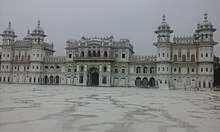
Janakpurdham जनकपुरधाम | |
|---|---|
Sub-metropolitan city | |
   Clockwise from top Janaki Mandir, Vivah Mandap, Ganga Sagar and Railway track | |
| Motto(s): City of religious and cultural significance | |
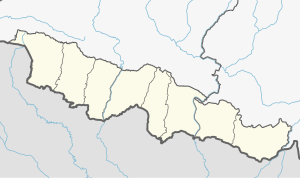 Janakpurdham Location in Province No. 2 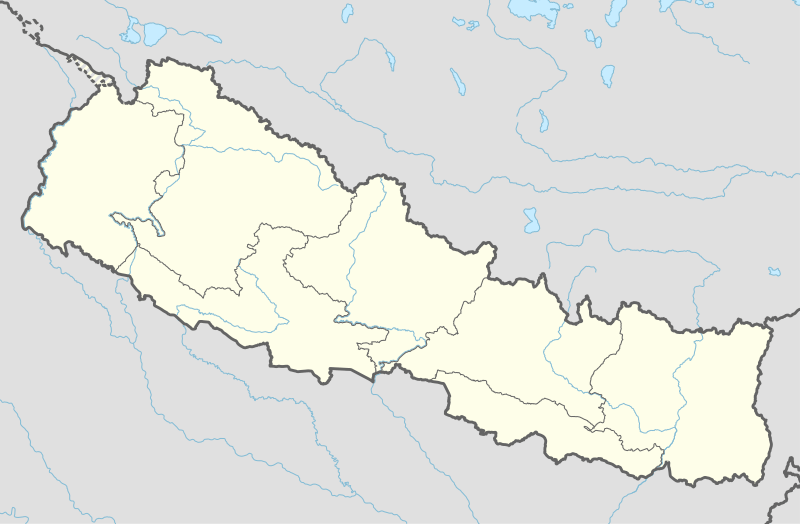 Janakpurdham Janakpurdham (Nepal) | |
| Coordinates: 26°43′43″N 85°55′30″E | |
| Country | Nepal |
| District | Dhanusha District |
| Government | |
| • Mayor | Mr. Lal Kishor Sah (RJPN) |
| • Deputy Mayor | Mrs. Rita Kumari Mishra (RJPN) |
| Area | |
| • Total | 100.20 km2 (38.69 sq mi) |
| Elevation | 74 m (243 ft) |
| Population (2015) | |
| • Total | 173,924 |
| • Density | 1,700/km2 (4,500/sq mi) |
| Languages | |
| • Official | Maithili |
| Time zone | UTC+5:45 (NST) |
| Postal code | 45600 |
| Area code(s) | 041 |
| Website | http://janakpurmun.gov.np |
This city, also known as Janakpurdham, was founded in the early 18th century. According to oral tradition, an earlier city existed in the area, also known as Janakpurdham, which was the capital of the Videha dynasty that ruled Mithila region in the ancient times.[2]

The city is located about 225 km (140 mi) south-east of Kathmandu.[3] As of 2015, the city had a population of 173,924 making it the largest Sub-Metropolitan city of Nepal.[4] Janakpur is currently the third largest city in the Terai (after Biratnagar and Birgunj) and the seventh largest in Nepal.
Nepal Railways used to operate between Janakpur and India.
History

Accounts of ascetics, pandits and bards indicate that Janakpur was founded in the early 18th century. The earliest description of Janakpur as a pilgrimage site dates to 1805. Earlier archaeological evidence of the presence of an ancient city has not been found. King Janaka's palace is thought to have been located in ancient Janakpur as it is thought to be the capital of the Kingdom of the Videhas. According to the Hindu Epic Ramayana, he found a baby girl in a furrow, named her Sita and raised her as his daughter. When she was older, he offered her in marriage to anyone who was able to lift the bow of Shiva, left near Janakpur a thousand years earlier. Many royal suitors tried, but only Rama, prince of Ayodhya, could lift the bow. According to an old song, this bow was found northeast of Janakpur.[2]
Until the 1950s, Janakpur was a cluster of rural hamlets inhabited by farmers, artisans, priests and clerks who worked for the monasteries that controlled the land. After independence in India, Janakpur expanded to a commercial centre and became the capital of the Dhanusa District in the 1960s.[5]
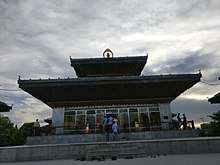
As Rama and Sita are major figures in Hinduism, Janakpur is an important pilgrimage site for Hindus all over the world. According to the first millennium text Shatapatha Brahmana, the Maithil king Videgha Māthava crossed the Sadānirā (Gandaki River), led by his priest Gotama Rahugana, and founded the Kingdom of Videha with Janakpur as capital city. As Gotama Rahugana composed many hymns of the Rigveda, these events must date to the Regvedic period.[6]
Gautama Buddha, the founder of Buddhism, and Vardhamana Mahavira, the 24th and final Tirthankara of the Jain religion, are said to have lived in Janakpur. The region was an important centre for the history of Mithila during the first millennium.[7]
Geography and climate
Janakpur is located in the Terai, where the climate is humid suptropical (Cwa): the months of March and April are hot, dry and windy; the monsoon lasts from May to September, followed by a mild dry autumn from October to November and a cold winter from December to February.[5]
The major rivers surrounding Janakpur are Dudhmati, Jalad, Rato, Balan and Kamala.
| Climate data for Janakpur Airport (1981-2010) | |||||||||||||
|---|---|---|---|---|---|---|---|---|---|---|---|---|---|
| Month | Jan | Feb | Mar | Apr | May | Jun | Jul | Aug | Sep | Oct | Nov | Dec | Year |
| Average high °C (°F) | 22.2 (72.0) |
26.0 (78.8) |
31.2 (88.2) |
34.8 (94.6) |
34.6 (94.3) |
34.1 (93.4) |
32.5 (90.5) |
32.7 (90.9) |
32.3 (90.1) |
31.7 (89.1) |
29.3 (84.7) |
25.1 (77.2) |
30.5 (86.9) |
| Daily mean °C (°F) | 15.6 (60.1) |
18.6 (65.5) |
23.4 (74.1) |
27.7 (81.9) |
29.3 (84.7) |
30.0 (86.0) |
29.3 (84.7) |
29.6 (85.3) |
28.8 (83.8) |
26.8 (80.2) |
22.5 (72.5) |
18.0 (64.4) |
25.0 (77.0) |
| Average low °C (°F) | 9.1 (48.4) |
11.3 (52.3) |
15.5 (59.9) |
20.6 (69.1) |
24.0 (75.2) |
25.9 (78.6) |
26.1 (79.0) |
26.4 (79.5) |
25.3 (77.5) |
22.0 (71.6) |
15.7 (60.3) |
10.9 (51.6) |
19.4 (66.9) |
| Average precipitation mm (inches) | 11.7 (0.46) |
11.4 (0.45) |
11.5 (0.45) |
52.2 (2.06) |
128.3 (5.05) |
238.7 (9.40) |
487.6 (19.20) |
339.4 (13.36) |
197.5 (7.78) |
63.9 (2.52) |
1.9 (0.07) |
8.4 (0.33) |
1,552.5 (61.12) |
| Source: [8] | |||||||||||||
Economy
Janakpur is one of the fastest developing cities of Nepal, and is the largest sub-metropolitan city of Nepal.[9] The city has good health care facilities, and a number of parks as well as good private schools, colleges and internet service providers. There are medical and engineering and management colleges which are affiliated to the Tribhuvan University. The economy is mostly based on tourism, agriculture and local industries.
The paintings on pottery, walls and courtyards made by Maithili women are known as Mithila Art.
Janakpur attracts migrants from the surrounding area, moving to the city for medical care, education and jobs. The largest employer was the Janakpur Cigarette Factory Limited and Janakpur Railway until 2013, now both were closed due to political corruption but by the end of 2018, it is re prepared to start their services again.[10] Zonal Hospital,Zonal Police location and Banking Sector to help easy Life Style. Many more Market in local Area in different places.Many kinds of shops are available. Now started boating in Ganga Sagar 2071 Jestha B.S. By the Help of Nepali Army and Local People. Mall,Cafe 3 Star Hostels are also opened and many more Restaurant etc. life is easy anyway. Nepal Rastra Bank facilitates many people residing.The city has burgeon with its qualities many kind of Commercial Bank are there like state Bank of India,Nepal, Everest Bank LTD. . Machhapuchhare,NIC Bank, Nepal Bank LTD, Agriculture Development Bank etc.Alao Available Join venture Bank with Punjab National Bank.Cinema hall are there like Ram Janki Cinema Hall,Aasha hall, Hanuman Hall, Nilam hall and Girija 3D.Cinema Hall.
Transport
Roadways
Frequent bus services operate between Janakpur and other cities of Nepal. Within the city, cycle rickshaws, electric rickshaws, tempos and buses are available.
Railways
Nepal Railways is the only operational railway in Nepal. It connects Janakpur to Siraha at the Nepal-India border and further goes to the Indian city of Jaynagar, Bihar. There is a customs checkpoint in Siraha for goods.[10]
Airways
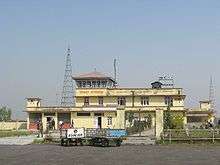
Janakpur has a domestic airport (IATA: JKR, ICAO: VNJP) with most flights connecting to Kathmandu.[11]
| Airlines | Destinations |
|---|---|
| Buddha Air | Kathmandu [12] |
| Shree Airlines | Kathmandu [13] |
| Yeti Airlines | Kathmandu [14] |
Demographics
As of June 2011, Janakpur municipality had 19,195 households and a population of 98,446 people with a density of 4,000 people per km2.[15] In 2015, it was declared a sub-metropolitan city incorporating 11 surrounding villages. the population is now 173,924 people, making it the sixth largest city in Nepal.[16]
Maithili language is widely spoken in the area as the first language and it is also the lingua franca. Nepali, Hindi, Marwari and English are well understood. Languages like Bhojpuri and Awadhi are understood but less frequently used.
More than 90% of the total population is Hindu, with the rest being Muslims and Buddhists.
Culture
Religious Sites
The centre of Janakpur is dominated by the impressive Janaki Mandir to the north and west of the bazaar. This temple, one of the biggest in Nepal, was built in 1898 (1955 in the Nepali calendar) by Queen Brisabhanu Kunwari of Tikamgarh. It is also called "Nau Lakha Mandir" after the cost of construction, said to be nine lakh rupees.[17]
In 1657, the great saint and poet Sannyasi Shurkishordas discovered a golden statue of the Goddess Sita at the place where she was born, which ultimately became the location of the current Janaki Mandir, the Temple of Sita.
Queen Brisabhanu Kunwari of Tikamgarh had the Janaki Mandir built in 1911. The temple is architecturally unique in Nepal. Its inner sanctum contains a flower-covered statue of Sita that was miraculously found in the Saryu River near Ayodhya. Statues of Rama and his half-brothers Lakshman, Bharat and Satrughna stand by Sita. In the early evenings, the temple is lit with colourful lights and filled with hundreds of pilgrims expressing devotion for Sita and Rama. Adjacent to the Janaki Mandir is the Rama Sita Vivaha Mandir, a building that marks the event in which Rama and Sita were married.However, Lord Ram and Goddess Sita were actually married at Mani Mandap present in the western part of Janakpur which retains a "Holy Pillar" as a symbol of the marriage.
The oldest temple in Janakpur is Sri Ram Temple, built by the Gorkhali General Amar Singh Thapa.[17] Pilgrims also visit the more than 200 sacred ponds in the city for ritual baths. The two most important ponds - Dhanush Sagar and Ganga Sagar, are located close to the city centre. The Vivah Mandap temple is situated next to the Janaki Mandir. Ram Tower is located to the south of Ram Temple. It was inaugurated by former Prime Minister Sushil Koirala.
- Deities of Sri Sita Devi (far right) and Sri Rama (centre) (with Sri Lakshmana (far left) and Sri Hanuman (below seated))
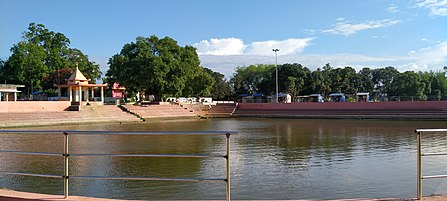 Pond in front of Mani mandap, Rani bazar. The place where marriage of Ram and Sita actually happened.
Pond in front of Mani mandap, Rani bazar. The place where marriage of Ram and Sita actually happened.- Ram Janaki Biwaha Mandap
 Hanuman Mandir, Kadam Chowk
Hanuman Mandir, Kadam Chowk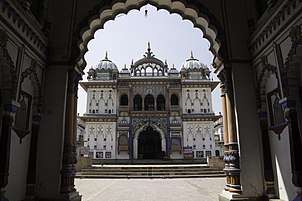 Janaki Mandir
Janaki Mandir
Festivals
Major religious celebrations include the Hindu festivals Vivaha Panchami, Dipawali, and Vijayadashami,[17] followed by Chhath Puja, which is celebrated six days after Dipawali and Makar Sankranti. Vijayadashami, Vivah Panchami and Chhath Pooja are celebrated in a carnival-like atmosphere.
On the full moon day of February/March before the festival of Holi, a one-day Parikrama (circumambulation) of the city is celebrated. Many people offer prostrated obeisances along the entire 8 km (5.0 mi) route. Two other festivals honour Rama and Sita: Rama Navami, the birthday of Lord Rama, in March–April, draws thousands of pilgrims.[18] The Vivah Panchami or Vivah festival re-enacts the wedding of Rama and Sita at the famous Vivah Mandap temple on the fifth day of the waxing moon in November or early December.
Sister Cities

- Area around Rajbiraj was the seat of brother of King Janak, Kushadhwaja father of Mandavi and Shruti Kirti. Rajdevi Temple of Rajbiraj is known to be the family temple of the family. The temple was later rebuilt by Sens of Makwanpur in around 14 century and again recently. There were shrines of Mandavi, Shruti kirti and Urmila around Rajbiraj but they have lost over time. Janakpur and Rajbiraj are part of Maithali circuit of Nepal with glorious Maithali traditions and a must visit for someone who wants to understand and know more about Maithali culture.
Education
Janakpur has good educational facilities and several elites of the country were schooled here, including the first president of the Federal Republic of Nepal, Dr. Ram Baran Yadav. There are many private and government schools and colleges located in Janakpur. The oldest government school for higher studies is Ramsworup Ramsagar Bahumukhi Campus (RR Multiple Campus), which is affiliated to Tribhuwan University. It offers undergraduate and post-graduate courses in several disciplines. Janakpur also boasts of having a medical college, Janaki Medical College,[20] which is also affiliated to Tribhuwan University. The 10th University of Nepal Rajarshi Janak University (RJU) is also going to be structured yet as the project has been implemented but there is no infrastructure so 3 yrs time is given for infrastructure management.
Colleges
- Ramshwaroop Ramsagar Multiple (RRM) Campus
- Dhanusha Science Campus, Janakpur
- Janaki Medical College
- Central Engineering College, Nepal Technical Institute, Janakpur-8.
- Janaki College of Management
- Model Multiple College, Janakpur-04, Ramchowk
- Mithila Institute of Technology, Janakpur-04
- National Academy
- New Millenium Campus
- Public Youth Campus, Kadamchowk, Janakpur
- Rajarshi Janak Campus, Murali Chowk
- Subhadra Matukdhari Campus
- Universal Academy
- New English Campus, Murali Chowk
- Sinha Health Foundation (BSC and BN), Janakpurdham-8
- University campus,janakpurdham
Libraries
Gangasagar Public Library was established in 1955 and is situated between two historical ponds of Janakpur — Dhanuschatra pond and Ganga Sagar. The library was reopened for the public in 2012. In recent times, a team of active and committed local youth workers have contributed to the revival of this library by organizing public book collections for the library, which lacks books and English language newspapers. It is open daily for three hours, mainly for newspaper-reading, but has few daily visitors.[21]
Ramswaroop Ramsagar Multiple Campus Library is also accessible to the general public.
Media
The local media of Janakpur primarily consists of several community radio stations, some TV channels and a few print newspapers, such as Janakpur Today. The local media of Janakpur primarily consists of, such as Mithila Jagaran.
List of radio stations in Maithili language
TV channels
- Appan TV
- TV Today
Online Papper
- www.mithilajagaran.com
Health
- Dhanusha Hospital
- Janakpur zonal hospital
- Janaki Eye hospital
- City Hospital
- Kavya hospital
- Janki Health care and Research centre
- Janakpur Children hospital
- Binaytara Foundation Cancer Center
2015 Nepal earthquake
According to Colin Stark at Columbia University, during the earthquake on 25 April 2015, "A part of India slid about one foot to 10 feet northwards and underneath Nepal in a matter of seconds. The part below Bihar slid under Nepal along a zone from Bharatpur, through Hetauda, to Janakpur."[22]
See also
References
- "Places proposed for temporary capitals of all seven provinces". kathmandutribune.com. 2 January 2018. Retrieved 2 January 2018.
- Burghart, R. (1978). The disappearance and reappearance of Janakpur. Kailash: A Journal of Himalayan Studies 6 (4): 257–284.
- "Distance from Kathmandu to Janakpur". www.distancefromto.net. Retrieved 8 September 2018.
- "Archived copy" (PDF). Archived from the original (PDF) on 31 July 2013. Retrieved 16 April 2015.CS1 maint: archived copy as title (link)
- Burghart, R. (1988.) Cultural knowledge of hygiene and sanitation as a basis for health development in Nepal. Contributions to Nepalese Studies 15 (2): 185–211.
- "Nepal-India relations: Ramayan circuit". The Himalayan Times. 22 November 2017. Retrieved 7 December 2018.
- Rastriya Samachar Samiti (2004). "More Indian tourists visit Janakpurdham". Himalayan Times, 17 January 2004.
- Department of Hydrology and Meteorology 2014.
- "स्थानिय तह". 103.69.124.141. Archived from the original on 31 August 2018. Retrieved 7 December 2018.
- "Janakpur railway nears completion". kathmandupost.ekantipur.com. Retrieved 7 December 2018.
- Magar, Arpana Ale. "India permits new air entry routes over Biratnagar, Janakpur". My Republica. Retrieved 7 December 2018.
- "Flight schedule". Buddha Air. Archived from the original on 18 September 2010. Retrieved 6 June 2010.
- "KTM TO JKR". www.shreeairlines.com. Shree Airlines. Retrieved 3 March 2020.
- "Scheduled flights". Yeti Airlines. Archived from the original on 10 June 2010. Retrieved 6 June 2010.
- Central Bureau of Statistics (2012). National Population and Housing Census 2011 (PDF). Kathmandu: Government of Nepal.
- "National Population and Housing Census 2011 - (Village Development Committee/Municipality) - Dhanusha" (PDF). Government of Nepal, National Planning Commission Secretariat, Central Bureau of Statistics. March 2014. Retrieved 7 December 2018. Cite journal requires
|journal=(help) - Mishra, K. C. (1996). Pilgrimage centres and tradition in Nepal. In: D. P. Dubey (ed) Rays and Ways of Indian Culture. M.D. Publications Pvt. Ltd., New Delhi.
- http://www.nepalvista.com/travel/janakpur.html
- "MoU on Twinning arrangements between Kathmandu-Varanasi, Janakpur-Ayodhya and Lumbini-Bodh Gaya as sister cities". pib.gov.in. Retrieved 8 March 2020.
- "Janaki Medical College". Retrieved 8 September 2018.
- Mishra, P. "Book Collection and Donation Program". Retrieved 27 March 2016.
- "'Part of India slid underneath Nepal'". The Hindu. 29 April 2015. Archived from the original on 1 May 2015. Retrieved 5 November 2016.
External links
| Wikivoyage has a travel guide for Janakpur. |
| Wikimedia Commons has media related to Janakpur. |
